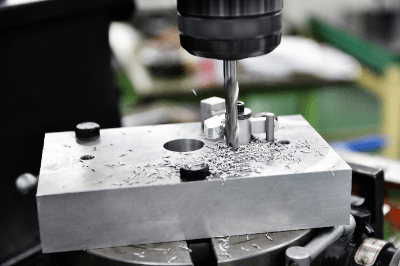What Is Aluminum Cutting?
 Aluminum cutting is a machining process that employs machine tools such as lathes, milling machines, NC machines, and machining centers to precisely “cut” and “shape” aluminum.
Aluminum cutting is a machining process that employs machine tools such as lathes, milling machines, NC machines, and machining centers to precisely “cut” and “shape” aluminum.
Compared to processes like pressing or molding, aluminum cutting allows for intricate machining in specific areas, enabling the fabrication of complex shapes. Aluminum’s lightweight nature and excellent machinability make it possible to create precise components, making aluminum cutting a common method across various industries.
Uses of Aluminum Cutting
Aluminum cutting is employed as a machining technique for crafting machine parts that require precision and take advantage of the diverse properties of aluminum. It is used in various applications, including:
1. Machining Parts Affected by Magnetic Fields
Aluminum, being non-magnetic, is ideal for components susceptible to magnetic fields, such as electronic medical equipment, mechatronics equipment, and linear motor vehicles, ensuring unaffected operation.
2. Machining Parts Requiring High Thermal Conductivity
Aluminum’s exceptional thermal conductivity, approximately three times that of steel, makes it suitable for crafting air conditioning and heating equipment, engine parts, heat dissipation fins, and heat sinks with demanding thermal properties and intricate shapes.
3. Machining Parts for Low-Temperature Environments
Aluminum can withstand low-temperature environments without brittle fracture, making it ideal for applications involving extreme cold, such as handling liquid nitrogen (-385°F) or liquid oxygen (-360°F). This has led to its use in fields like space development and superconductivity, where precision and material characteristics are critical.
Principle of Aluminum Cutting
Aluminum cutting involves the removal of unwanted material from aluminum using specialized machine tools, shaping it to the desired form and size with precision. This process allows for the creation of a wide range of shapes and high-precision components.
However, complex shapes may require multiple cutting tools and methods, which can increase time and cost. Aluminum alloys, commonly used in components, are assigned numbers ranging from 1000 to 7000 based on their composition. The 5000 series is well-suited for aluminum cutting.
Other Information on Aluminum Cutting
1. Addressing Welding in Aluminum Cutting
During aluminum cutting, the material can melt, leading to welding on the cutting edge. This can affect machining accuracy and cause quality issues. Two methods can prevent weld deposition: “blowing away chips with air” and “using cutting fluid during machining.” These approaches help maintain machining precision and prevent welding issues.
2. Additional Challenges in Aluminum Cutting
While aluminum is suitable for cutting and can be machined continuously for extended periods, it poses some challenges due to its characteristics:
Issues with Long Aluminum Chips: Long chips generated during prolonged cutting can be problematic if they get entangled in the cutting machine, potentially causing machine failure or interruptions.
Concerns Related to the Softness of Aluminum Alloys: Aluminum alloys used in cutting are soft materials and can deform during chucking, especially for lightweight, thin-walled, and long components. Chucking with hard steel fixtures may damage the soft aluminum alloy surface, potentially impacting quality.
Challenges Due to the Formation of an Altered Layer: The surface layer of aluminum cuttings may form an altered layer with different properties than the internal layer, resulting in increased hardness and residual stress. This can necessitate adjustments in subsequent processes and reduce work efficiency.
Impact of Large Cutting Oil Usage: Aluminum cutting often requires a significant amount of cutting oil to prevent surface plucking. Using a large amount of cutting oil increases initial costs for anti-scattering equipment and ongoing costs related to oil replacement.